Making movies. Enjoying movies. Remembering movies.
|
|
|
|
Related Articles:
|
Posted November 9, 2005 |
|
Magically Pristine "Cinderella" DVD |
By
William Kallay

Hot on “Bambi’s”
hoofs, Walt Disney’s 1950 classic, “Cinderella” has finally arrived on DVD.
This year has seen “Bambi,” and now “Cinderella,” receiving deluxe treatment
in picture & sound enhancement, and bonus material from the Disney vaults.
The new edition of Charles Perrault’s classic, as seen through the eyes of
Disney’s artists, has had an extreme makeover like the other recent animated
titles recently released by the studio.
“Cinderella” was salvation for the Disney Studio’s fortunes. Battered by
foreign box office during World War II, the studio had not produced an
animated feature since “Bambi” in 1942. Most of the studio’s efforts were
focused on making propaganda and training films in cooperation with the
United States government, as well as shorts featuring the studio’s talent
like Mickey Mouse and Donald Duck, and anthology films like “Make Mine
Music” (1946). By 1950, Disney was ready to unveil “Cinderella” onto the
public, and audiences loved it. The film was a hit and has seen success in
various re-releases since then. It has been released on VHS and Laser Disc
in the past, first in 1988 and then in 1995. The latest home video release
of the film is now available on a 2-disc DVD set.
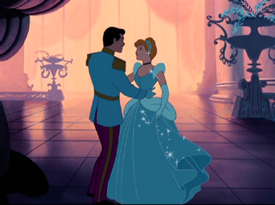 |
Disc 1 contains the
feature film, “A Dream Is A Wish Your Heart Makes” music video featuring
various Disney Channel stars, “Making Of ‘A Dream Is A Wish Your Heart
Makes,’” “Everybody Can Be A Princess” music video, and a real stretch of a
video segment, “Cinderella Stories” Presented by ESPN Classic. Nothing like
princesses and ESPN, but the segments are fun to see. The film features a
new 5.1 Disney Enhanced Home Theater Mix, a mono mix, and foreign language
tracks. Also featured are the usual “Sneak Peeks.”
Disc 2 contains an almost endless array of bonus features which are
well-worth the price of this DVD set. Since there are many, it’s best to
focus on the highlights. Deleted scenes featuring the original version of
“The Work Song” and “Dancing On A Cloud” have been reconstructed using
sketches. The core of this disc is in the “Backstage Disney” section, where
viewers will find ten separate features. A personal favorite is “From Walt
Disney’s Table: A Tribute To Disney’s Nine Old Men.” Present day animation
icons, including Don Hahn and Brad Bird, talk with other animation pros and
host Joe Siegel (“Good Morning America”) to discuss Walt Disney’s “Nine Old
Men,” a group of his finest animators. If you’re a Disney animation buff,
this all too short segment gives you a glimpse into not only into the Nine
Old Men themselves, but the influence that those early Disney artists had on
Disney and Pixar animators. And when I say “too short,” it’s meant as a
compliment. It could’ve been nice to listen to these animators talk for
longer.
The producers of the bonus material have also included tributes to artist
Mary Blair, who is probably best known for her work on the designs of the
It’s A Small World attraction. Navigating further into the disc will bring
viewers “From Rags To Riches: The Making Of ‘Cinderella,’” “The Cinderella
That Almost Was,” storyboard comparisons, still galleries, original
trailers, the original Laugh-O-Gram short of the story (1922), a “Mickey
Mouse Club” segment, and songs from the film and television segments. Also
on the disc are games that can be played on a PC and “House Of Royalty,” a
segment featuring actress Alyson Stoner from Disney Channel’s “Mike’s Super
Short Show.”
The picture is worthy of a home theatre set-up. It’s clear and bright, and
as long as most people view it in 1.33:1, and not stretched or cropped to
fill their 16:9 display, it can be a very enjoyable experience. The images
are dazzling and the soundtrack is pleasant to listen to. The Dolby Digital
“Disney Enhanced” mix is subtle. The sound mixers have balanced the original
mono tracks tastefully across the screen channels with minimal surround
action, and that’s the way a good mix ought to be on an old film such as
this. For purists, a monophonic track is available.
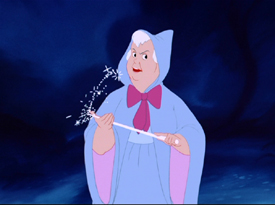 |
The film was
restored by Lowry Digital Images, which is now owned by DTS Images. Lowry
has digitally cleaned and fixed a number of classic films in recent years,
including the original “Star Wars” films, Indiana Jones trilogy, and a
number of Disney’s animated features. The work is extraordinary to see,
especially in animation. When “Snow White And The Seven Dwarfs” was released
on DVD in 2000, there was jubilation amongst many who bought the DVD. It
just looked so good.
But I have reservations about how much digital “restoration” was done on
“Cinderella.” This is used just as an example. Other notable Disney features
have been digitally restored like “Snow White,” and “Bambi.” With respect to
Mr. Lowry and Dave Bossert, who have done wonderful work in restoring many
Disney films and shorts, this is merely an observation.
It may be a simplistic observation, especially with all of the time,
technology, money and work that went into the digital version of
“Cinderella,” but the film now looks like it went through Photoshop,
frame-by-frame. The film feels and sounds almost like it was made yesterday.
Perhaps that’s great for the little children of today’s digital age, but not
for those of us who originally saw it in a theatre.
According to a source at Disney, to go unnamed, “Cinderella” was digitally
restored, not only to archive the film, but to make it look presentable for
today’s audiences. We’re talking about a film that was made 55-years ago.
“Cinderella” no longer feels like a film made by human hands, but more like
a film made on a computer. That’s not a bad thing. Witness what Pixar has
done. But this film wasn’t made in an era of computer animation. It was made
with an artist’s brush strokes and analog technology. It was a different
beast, if you will. This newfound revelation of “here’s what we can do with
digital technology” is harmful in that the original artist’s work is
altered. What is also changed is the audience’s perception of the movie.
Certainly, the story, the wonderful characters and great songs are still
there. The great animation is there. But the whole impact of the movie now
feels somewhat sterile. As far as how this new version of the classic looks,
it now looks almost identical to the dreadful made-for-DVD sequel,
“Cinderella II: Dreams Come True” (2002). Perhaps Disney did this on purpose
to brace home video customers for the arrival of “Cinderella III.”
Certain films, in my opinion, should reflect the time they were made, and
they should reflect the technology they were made with. There doesn’t seem
to be much sense in the adage that “if they had this kind of technology back
then, they’d use it!” Well, they didn’t. I can’t imagine the animators at
Disney during the late-1940s saying they’d use computers to make animated
films. I can’t imagine them thinking of doing elaborate Multiplane Camera
shots of “Cinderella” on a workstation. None of this was at their disposal
back then. Try as they could to get rid of dirt and scratches on cels, some
snuck in and could be seen for generations to come. No single audience
member ever complained about those pesky bits of dust and flotsam floating
around the opening shots of “Pinocchio” (1940).
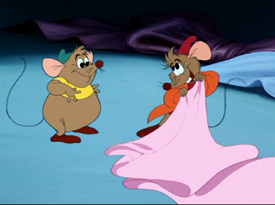 |
Some of the classics
benefit from being ultra-clear in picture. “Sleeping Beauty” (1959), which
was shot in Technirama, was already sharp and clear due to the large
negative and anamorphic lenses used to make that film. The film, by nature,
was meant to look sharp, so any enhancement done on that film was
unnecessary. What’s troubling is that these same digital techniques have
been applied to the upcoming “Lady And The Tramp” DVD, due in February 2006.
That film was shot with the early CinemaScope lenses, which were undoubtedly
soft. They had cast their own distinct look upon films of the era. Perfect,
no, but when shown from a brand-new print, they looked good and presentable.
Where has Disney’s animation, just as an example, looked excellent and sharp
for DVD, but also retained the look and feel of the original film? The Walt
Disney Treasures series has been a perfect example. A case in point would be
on the Silly Symphonies set. These DVDs are so much more true to the source
cartoons than many of the recent feature-length animated classics are. Film
grain is present on these shorts, but it’s acceptable. The sound still
retains that old-time “high fidelity” that Disney used. Yet it feels like
you’re watching a film rather than a sterilized movie made for DVD. Why
couldn’t “Cinderella” have gotten that same treatment?
Lowry Digital Images has done a tremendous job in making some older films
shine. Great examples of this can be seen in “Sunset Blvd” (1950), “The
Empire Strikes Back” (1980) and the Indiana Jones trilogy (1981, 1984 and
1989.) Those films, with few exceptions, looked natural as the day they were
shown in theatres. But why are certain titles, in particular the vaunted
Disney classics, overly clean?
This isn’t to say
what Disney and Lowry have done is terrible. In fact, it’s admirable that
they’ve taken restoration very seriously. But how much is too much?
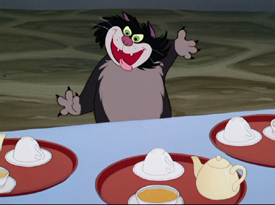 |
One of the problems
with DVD culture is that there is an expectation that every vintage film
should look like today’s movies with today’s crisp film stock. The
soundtrack should be ablaze in 5.1 surround sound. But not all films fall
into this category. Some films should look grainy by their nature or reflect
the flaws in the film stock they were shot on. Imagine documentaries made by
the Maysles Bros. (“Gimme Shelter” – 1970) de-grained as “Cinderella” has
been. How about a full-fledged multichannel remix of Woody Allen’s entire
film catalog? The films would certainly feel different. It’s kind of like
putting 18-inch rims on a Model T. Sure, it looks kind of cool at first, but
it just ain’t right.
And how about the film? One of the reasons why “Cinderella” has been so
successful and consistently popular with audiences is the film hits on all
cylinders. Disney and his staff were masters of the visual storytelling
medium. Only they could combine a very human heroine in Cinderella with cute
little animals and cartoonish stepsisters, all singing, and get away with
it.
“Cinderella” is truly an audience film. Get a crowd of children and adults
to see this film, there is almost a guarantee that they’ll be cheering and
clapping at the end. There isn’t a better moment in the film that gets the
audience on the edge of its seat than the scene in which the mice try to
save Cinderella. Pure suspense! The scenes that take place in the cracks and
behind walls where we see things from a mouse’s point-of-view are priceless,
too.
All of the characters in “Cinderella,” as done by Disney, are enjoyable.
Cinderella (Ilene Woods) is a better heroine than Snow White was. Where as
Snow White was a little too cutesy and somewhat sarcastic when it came to
the Dwarfs, Cinderella is more real and approachable. One feels her pain and
despair when her wicked stepsisters rip her dress to shreds. We’re also relieved when she reveals to the Grand Duke that she’s got the other glass
slipper.
Lady Tremaine (Elanor Audley) is truly wicked and delightful to watch.
Perhaps not as scary as the Wicked Queen or Stromboli, Lady Tremaine is
nonetheless commanding of her screen time. Anastasia (Lucille Bliss) and
Drizella (Rhonda Williams) are funny in their roles, but perhaps not as
memorable as those of the mice, Jaq and Gus (played by Disney Studio
soundman, James MacDonald), and Lucifer the cat (June Foray). The funniest
scenes in the film are a result of the side antics of these characters. One
particular favorite, and it seems to be a favorite of those folks featured
on the bonus disc, is Lucifer’s scene in the kitchen as he tries to find Gus
under some cups. His jubilation of thinking he’s found Gus is hilarious and
shows what a funny animator Ward Kimball was.
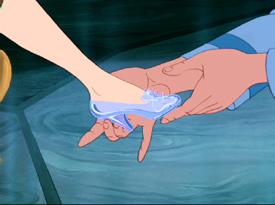 |
The music and score
are truly memorable. Songs like “A Dream Is A Wish Your Heart Makes” and
“The Work Song” are still heard in Disney theme parks, and can almost be
recited by anyone today. This was real song writing, and the score lends
itself perfectly to each and every scene in the film without being
overbearing or repetitive.
“Cinderella” is a true masterpiece in the Disney film line up. By all means,
seek out this disc and buy it, simply because “Cinderella” is a wonderful
film, and the bonus features outweigh any reservation this author might have
about the “restoration.” And it is a matter of visual preference.
Cinderella
Walt Disney Home Entertainment
Catalog Number 35024
Region 1
1.33:1
Dolby Digital 5.1 (Disney Enhanced Home Theater Mix)
Dolby Digital 1.0
DVD Release Date: December 4, 2005
$29.99
G
Two DVD-9 Discs
1950
77 minutes
Color
Directors: Wilfred Jackson, Hamilton Luske, Clyde Geronimi
Cast:
Claire Du Brey, Don Barclay, Eleanor Audley, Ilene Woods, James MacDonald,
Luis Van Rooten, Rhoda Williams, Verna Felton
Special Thanks to Amelia McPartlon
IMAGES: © Buena Vista Home Entertainment, Inc. All rights reserved
